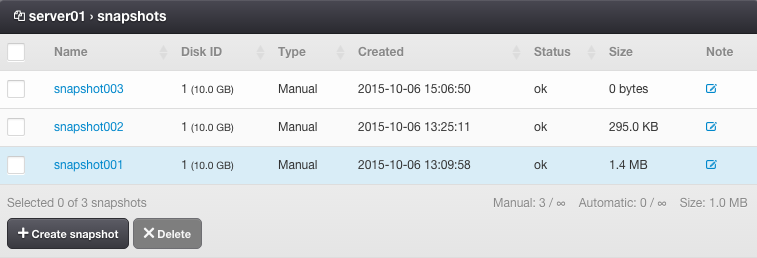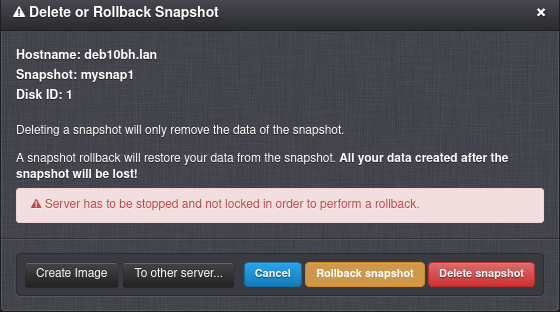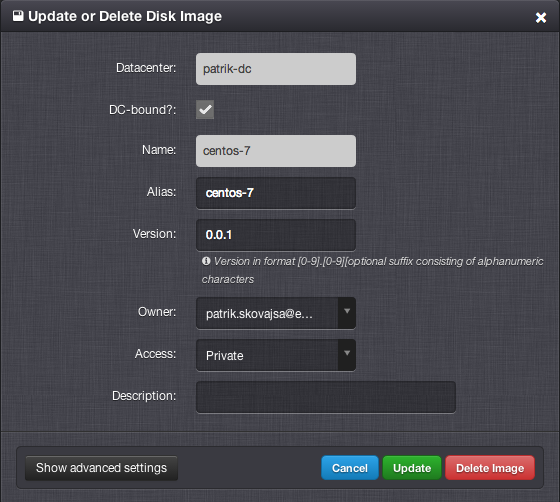Virtual Server Snapshots¶
A Snapshot is a local backup of a virtual server disk. A snapshot does not take up any disk capacity at the time of creation. The disk capacity is consumed only by changes performed on the disk after the snapshot’s creation.

| Access Permissions | |
| SuperAdmin | read-write |
| DCAdmin | read-write |
| VmOwner | read-write |
Note
Creating a snapshot and performing a rollback are instant operations. It is recommended to create a snapshot before performing any non-trivial action inside the virtual server.
Warning
Snapshots are stored on the same node storage as virtual server disks used for the snapshots. Failure of a node storage, therefore, results in loss of snapshots.
Snapshot Parameters¶
Name - Snapshot name (read-only).
Disk ID - Virtual server disk ID (read-only).
Type - Snapshot type (read-only). One of:
- Manual
- Automatic
Created - The date and time when the snapshot was created (read-only).
Status - Snapshot state (read-only). One of:
- ok
- pending
- rollback
- lost
Size - The approximate size of the snapshot (read-only).
Note
Note
The snapshot size parameter is automatically updated once every hour.
Note
Snapshots created with the Freeze filesystem option enabled are marked with a flag icon appended to their status.
Advanced Snapshot Parameters¶
- Freeze filesystem? - Whether to create an application-consistent snapshot (KVM only). Requires QEMU Guest Agent to be running inside the virtual server.
Snapshot Actions¶
Create snapshot - Immediately create a snapshot from one or all virtual server’s disks.

Delete snapshot - Remove data of the snapshot.

Rollback snapshot - Restore server disk data from the snapshot.
Warning
A snapshot rollback will lead to deletion of all data including every newer snapshot created after the restored snapshot.
To other server… - Restore server disk data from the snapshot to a different virtual server’s disk. The destination disk must have the same size.
Note
The destination disk will be completely erased including all snapshots. Snapshots from the source disk (that are older than the restored snapshot) will be present in the destination disk.
Note
This functionality is available in the API as
PUT /vm/(hostname_or_uuid)/snapshot/(snapname).
Snapshot Definitions¶
A Snapshot Definition is a configuration based on which periodic snapshots are automatically created and deleted.

| Access Permissions | |
| SuperAdmin | read-write |
| DCAdmin | read-write |
| VmOwner | read-only |
Snapshot Definition Parameters¶

- Name - Snapshot definition name.
- Disk ID - Virtual server disk ID.
- Schedule - Automatic scheduler configuration in Cron format. Use your local time for the hour field (it will be internally converted into UTC).
- Retention - Maximum number of snapshots to keep. After exceeding this number of snapshots, the oldest snapshot associated with the snapshot definition will be automatically removed.
- Active - Whether the snapshot definition is active.
- Description
Advanced Snapshot Definition Parameters¶
- Freeze filesystem? - Whether to create application-consistent snapshots (KVM only). Requires QEMU Guest Agent to be running inside the virtual server.
Cron Format¶
Cron format is a flexible way to define time and frequency of running a periodic task. It is defined as a string of five fields separated by a space.
| Field name | Allowed values |
|---|---|
| Minutes | 0-59 |
| Hours | 0-23 |
| Day of month | 1-31 |
| Month | 1-12 (January - December) |
| Day of week | 0-6 (Sunday - Saturday) |
Examples
30 08 10 06 *- Run a task once every year on June 10 at 8:30 AM.00 11,16 * * *- Run a task twice a day at 11:00 AM and 4:00 PM.00 09-17 * * *- Run a task once every hour between 9:00 AM and 5:00 PM.00 09-18 * * 1-5- Run a task once every hour between 9:00 AM and 5:00 PM from Monday till Friday.* * * * *- Run a task once every minute.0,10,20,30,40,50 * * * *- Run a task once every 10 minutes.0,2,4,6,8,10 * * * *- Run a task every 2 minutes during the first 10 minutes of a hour.0 0 1 1 *- Run a task once a year at midnight of January 1.0 0 * * *- Run a task once a day at midnight.0 * * * *- Run a task once an hour at the beginning of the hour.
Creating an Image From a Snapshot¶

Name - Unique image identifier (usually used in the API).
Alias - A user-defined name of an image (usually displayed in the GUI).
Version - Image version.
Access - Image visibility. One of:
- Public - Image is usable by all users in this virtual data center.
- Private - Image is usable by SuperAdmins and owners of this image.
- Deleted - Image is hidden and unusable for new servers, but can be still used by some already defined servers.
Owner - Image owner.
Tags - Comma-separated list of image tags, which will be inherited by virtual servers that will use this image.
Resizable? (Resize) - Specifies whether an image is able to resize a virtual disk during an initial start or deploy procedure. This is usually achieved by a post-installation script that has to be included in the disk image.
Shutdown after deploy? (Deploy) - Specifies whether an image is able to shut down a virtual server after an initial start. Such an image should include a post-installation script, which will shut down the running operating system after it has been successfully configured. After a virtual server is stopped, it is considered to be successfully deployed, and it will be automatically started by the system.
Description
See also
More information about disk images can be found in a separate chapter.